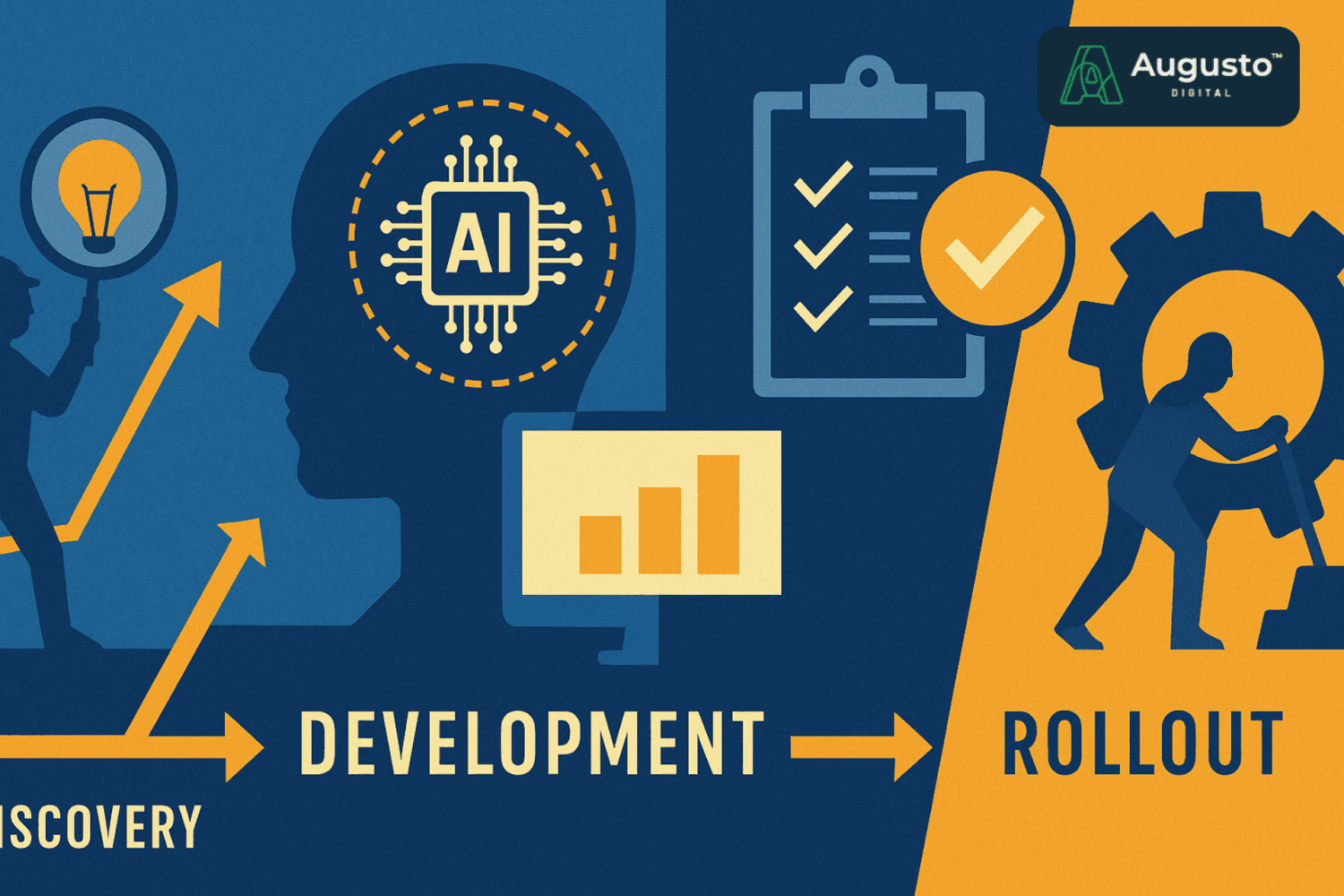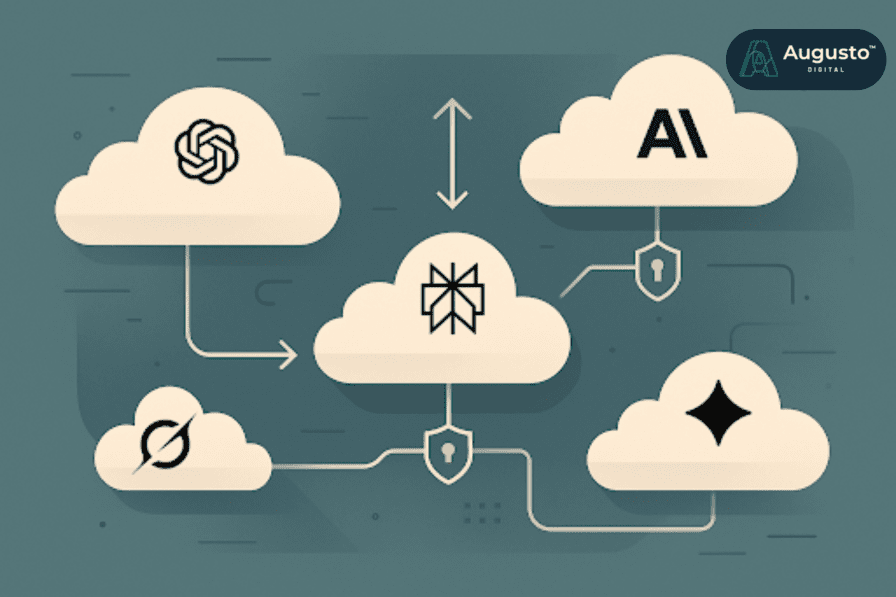AI workflows are central to maximizing efficiency and innovation in businesses. By exploring the four key stages of AI workflow, businesses can implement AI solutions more effectively. From discovery to rollout, each phase offers insights specific to integrating AI into business operations, enhancing product capabilities, and optimizing processes.
The Discovery Phase
The discovery phase in an AI workflow is pivotal for businesses aiming to strategically integrate AI solutions. This phase emphasizes a comprehensive assessment of business needs and the current data landscape, identifying AI opportunities that align with core objectives. Developing a tailored AI strategy in this phase ensures that the technology complements and enhances existing business processes, rather than disrupting them.
Consulting services can play a crucial role in this stage by providing expert insights into AI possibilities and limitations. These services help in formulating a strategy that is not only technologically feasible but also economically viable. By leveraging domain expertise and data insights, businesses can uncover hidden opportunities for AI integration that might not be immediately apparent.
The discovery phase sets the stage for successful AI implementation by clarifying goals and identifying relevant data sources. This clarity is essential for the subsequent development phase, where bespoke AI solutions are crafted. Engaging with consulting services ensures that businesses devise a strategic roadmap, avoiding pitfalls and maximizing potential returns.
For more insights into strategically integrating AI with business goals, consider exploring how Custom GPTs Can Transform Your Business Strategy.
The Development Phase
The development phase is where AI transformation truly takes shape. This involves crafting bespoke AI applications through a cycle of build, test, and refine to ensure alignment with strategic business objectives. Experienced professionals leverage skills in data science, machine learning, and software engineering to create solutions that not only meet technical specifications but also enhance user experience and operational efficiency.
Custom AI applications, including natural language processing models, are an example of innovation in this phase. These applications are tailored to automate specific tasks, thereby reducing manual workload and human error. This approach optimizes performance by focusing on the unique requirements of each business.
Development is not a linear process. Iterative testing and feedback loops are crucial to refine models and algorithms. This adaptability is key to meeting evolving business needs and responding to market changes. By integrating agile methodologies, teams can quickly pivot and adapt, ensuring that the final product is robust and effective.
Incorporating AI-driven solutions leads to improved decision-making processes and competitive advantage. Utilizing frameworks that support AI development accelerates the deployment and scaling of these solutions, providing immediate and tangible benefits to businesses.
The Validation Phase
In the validation phase of the AI workflow, each solution is meticulously tested to ensure its accuracy, reliability, and adherence to ethical standards. This stage is paramount in mitigating risks and verifying that AI models perform at a level that meets the specified business standards. By conducting comprehensive testing across a wide range of scenarios, businesses can assure themselves that the AI technology they deploy is both robust and adaptable.
Validation is not merely a checkmark in the development process; it’s an essential step to prevent unforeseen issues when AI solutions face real-world conditions. This phase involves validating data integrity, model outputs, and operational compliance to ensure they are not only functional but also ethically sound. Such thorough evaluations are vital in avoiding bias in AI solutions, which can have significant ethical and legal ramifications if not properly addressed.
To ensure your AI solutions maintain high performance standards and ethical considerations, it’s beneficial to employ strategies that offer continuous improvement. Techniques such as ongoing model training and adjustments to support system changes or advancements in AI capabilities can significantly enhance outcomes. Maintaining an ethical approach requires consistent vigilance, making validation an ongoing effort rather than a one-time task. By focusing on the validation phase’s critical components, organizations can lay the groundwork for successful AI integration, which seamlessly aligns with their operational goals.
The Rollout Phase
The rollout phase is crucial in embedding AI solutions into the fabric of business operations. It requires a well-structured process to ensure smooth integration with existing systems. Critical to this phase is the training of employees, enabling them to comprehend the tools and their significance in enhancing productivity. Ensuring employees are comfortable with these new systems is essential for maximizing AI’s potential.
Monitoring performance is equally important. This involves setting up mechanisms to continually assess the AI system’s efficiency and effectiveness. Regular performance evaluations help identify areas requiring fine-tuning, ensuring the AI solution operates at optimal levels. Ongoing support is another critical component, offering a safety net for both the system and its users. It ensures that any issues are promptly addressed, maintaining the reliability and security of business operations.
For successful integration, employees must understand the importance of AI in bolstering workflows while safeguarding security measures. This phase offers businesses a glimpse of AI’s transformative power, highlighting its potential to redefine operations.
For businesses eager to explore AI integration, you can read more on Transforming the Patient Journey and Reducing Costs with AI Chatbots. This resource offers valuable perspectives on utilizing AI to enhance business strategies.
Final Words
The four stages of AI workflow — discovery, development, validation, and rollout — describe a comprehensive path for leveraging AI. They guide businesses to implement solutions that optimize operations and enhance product functionality efficiently. Embracing this workflow enables businesses to navigate AI adoption seamlessly, ensuring consistent growth and innovation driven by intelligent technology.
Ready to Put AI to Work in Your Organization?
Whether you’re just beginning your AI journey or ready to accelerate, Augusto is here to guide the way. Our AI Solutions are designed to integrate seamlessly into your workflows, helping you unlock real value – early and often. Let’s build something transformative together.
Let's work together.
Partner with Augusto to streamline your digital operations, improve scalability, and enhance user experience. Whether you're facing infrastructure challenges or looking to elevate your digital strategy, our team is ready to help.
Schedule a Consult

